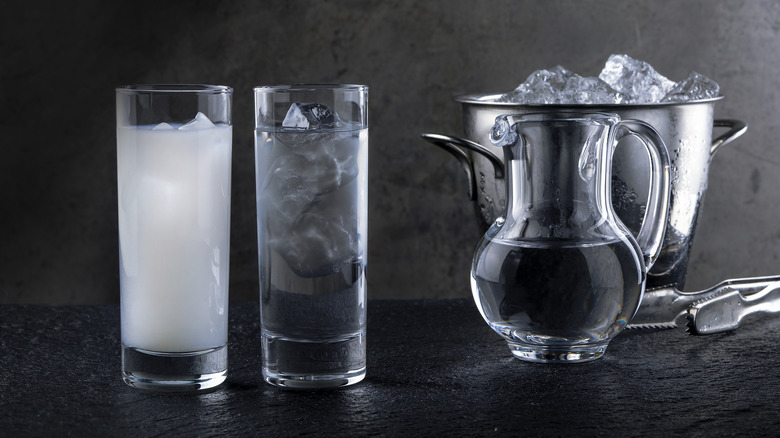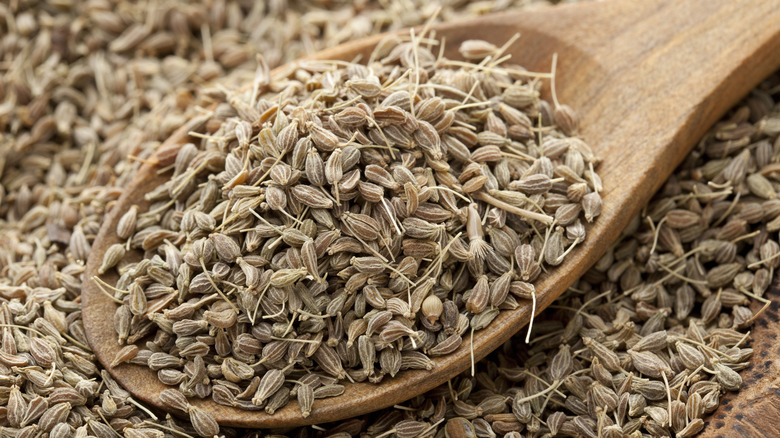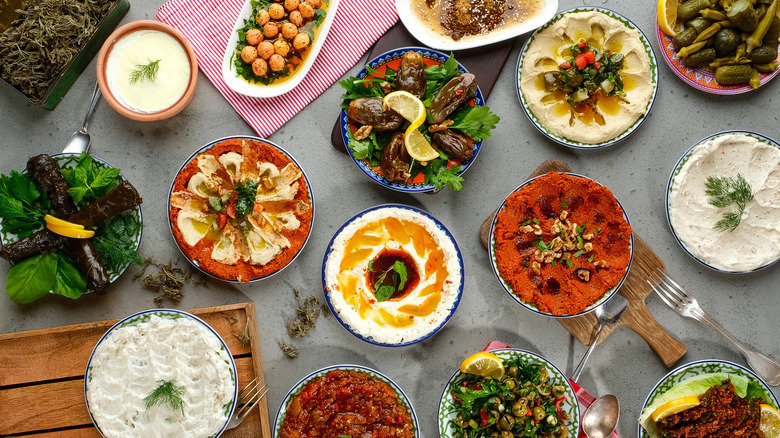The Best Pairing To Consume Raki, Turkey's Buzziest Liquor
Besides their capacity to intoxicate, many alcoholic beverages are renowned for their cultural importance and are therefore associated with certain life events or emotions. Bubbly champagne is the go-to for New Year's Eve, weddings, and baby shower toasts, beer goes hand-in-hand with barbecues, and wine is a sophisticated and romantic accompaniment to good food and good company. Even if it's not scientifically so, we blame tequila for craziness and whiskey for aggression (per Insider). Per Statista, the average American drinks nearly six liters of spirits alone annually, so that offers plenty of leeway to welcome something new and different, yet not unfamiliar. Something like raki.
Raki needs nothing but water or ice — no mixers required. Tradition says it's poured first into the thin, tall glass, then topped with the same proportion of water, and minimal ice, per Chicago Tribune. The newspaper's interview with Ozkan Yilmaz of the Windy City's Turkitch restaurant explains that to go out for raki means you want to discuss matters of great significance. CNN Travel says the spirit's nearly a folk medicine for broken hearts and troubled minds. When you clink your raki glasses together, you do it at the bottom, not the top, Yilmaz continues — with the most junior person in your party filling glasses and the eldest getting the first taste. Clearly, raki is steeped in social nuance and ritual — an experience not to be taken lightly but savored, together, in a Turkish tavern or meyhane (per Special Broadcasting Service). So what is it, exactly, that sets raki apart?
How does raki taste?
Raki is a Turkish anise-flavored alcoholic drink — anise (not to be confused with star anise) being a white-flowering herb related to carrots and prized for its fragrant seeds and medicinal properties (per Merriam-Webster). Britannica writes that drinks made with anise are widely consumed in the Middle East as well as the Mediterranean, and Liquor.com explains that cultures across the world have likewise found that aniseed is perfect for making spirits, naming other well-known examples like absinthe, sambuca, ouzo (which can only be made in Greece), and arak. Anise has a sweet flavor likened to licorice or fennel, and spice company McCormick explains that this also makes it ideal for baked goods, seafood, grilled meats, and pork sausage, or simply taken as a digestif. Its citrusy undertones pair wonderfully with orange, McCormick adds.
Britannica defines raki as crafted with grape or plum solids and twice-distilled, and Liquor.com says it can be made with dried or fresh grapes. It may have initially been made with what was left of grapes after winemaking, Britannica adds, and since it turns white when diluted (like many of its aniseed relatives, per Liquor.com), it's earned the moniker "lion's milk." The mixture that takes place isn't supposed to happen per science, but the so-called "ouzo effect," also known as louching or hazing (per Spirits Beacon), makes it happen because the normally insoluble oils in the anise and the introduced water or ice become emulsified (via Science Daily). What is supposed to happen when you drink raki is Turkish music, belly dancing, and eventually buzzed dancing with friends at the raki table (according to CNN).
How to drink and cook with raki
Britannica reports that traditionally, raki — at a hefty 45% alcohol — should be enjoyed with small plates of food called mezes that are shared at the table. These usually start with white cheese and melon, followed by cold seafood and vegetable morsels, then hot dishes of more seafood and meat, with deep and often uplifting discussions to follow, Britannica adds. If you're fortunate enough to travel to Turkey to see raki in its intended setting, know that it mustn't be imbibed heedlessly. If you do want to drink raki while visiting Turkey, Liquor.com cautions that you must opt for established brands as the counterfeit market is thriving there due to high taxes, and bootleg raki can contain potentially deadly methyl.
If you have raki at home, you can put its signature flavor to good use. Look to the Turkish mezes plates for inspiration, employing feta cheese or yogurt with lemon and olive oil, chopped eggplant in tomato sauce, spiced bulgur wheat salad, and fava bean dip, according to The Discoverer. You can be light and playful with cantaloupe, honeydew, and chevre, or bold and bright with pomegranate-braised lamb. Since it's similar to Pernod, perhaps try raki in seafood dishes like oysters Rockefeller, Ina Garten's Salmon Cured with Dill and Pernod or Cioppino, and Conor Pope's bouillabaisse stew in Irish Times. For further homage to its Turkish roots, try Australia's Special Broadcasting Service's mouthwatering Turkish-inspired raki tomato prawns with yogurt flatbread recipe. Raki is a storied drink that deserves a special place in your kitchen pantry. Best of all, the perfect pairing for the drink is simple water.


